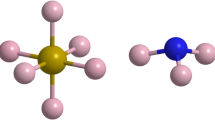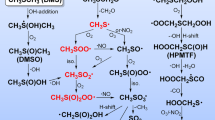Abstract
RECENTLY, Stein1 presented a chemical method of removing radioactive xenon from the effluent gases of nuclear power plants and fuel reprocessing plants. His chemical oxidant, O2+SbF6−, successfully trapped xenon and radon, but not krypton. This result is reasonable if the initial reaction is electron transfer from the noble gas, Ng, to the O2+ cation. Multistep fluorine (F and F−) transfer then produces NgF+. More quantitatively, the experimental ionization potentials for Rn and Xe, 10.748 eV and 12.130 eV (ref. 2) are, respectively, less than and commensurate with that of O2, 12.07 eV (ref. 3). Accordingly, electron transfer may be expected. Because the ionization potential of Kr is2 13.999 eV, however, no reaction is expected between O2+ and Kr.
This is a preview of subscription content, access via your institution
Access options
Subscribe to this journal
Receive 51 print issues and online access
$199.00 per year
only $3.90 per issue
Buy this article
- Purchase on Springer Link
- Instant access to full article PDF
Prices may be subject to local taxes which are calculated during checkout
Similar content being viewed by others
References
Stein, L., Nature, 243, 30 (1973).
Moore, C. E., Nat. Stand. Ref. Data Ser., 34 (US National Bureau of Standards, 1970).
Franklin, J. L., Dillard, J. G., Rosenstock, H. M., Herron, J. T., Draxl, K., and Field, F. H., Nat. Stand. Ref. Data Ser., 26 (US National Bureau of Standards, 1969).
Stein, L., Science, 168, 362 (1970).
Stein, L., Science, 175, 1463 (1972).
Lustig, M., Pitochelli, A. T., and Ruff, J. K., J. Amer. Chem. Soc., 84, 2841 (1962).
McKee, D. E., Adams, C. J., Zalkin, A., and Bartlett, N., J. Chem. Soc. Chem. Commun., 26 (1973).
Huheey, J. E., J. Chem. Ed., 45, 791 (1968).
Berkowitz, J., and Chupka, W. A., Chem. Phys. Lett., 7, 447 (1970).
Liu, B., and Schaeffer, III, H. F., J. Chem. Phys., 55, 2369 (1971).
Moy, D., and Young, A. R., J. Amer. Chem. Soc., 87, 1889 (1965).
Qureshi, A. M., and Aubke, F., Canad. J. Chem., 48, 3117 (1970).
Kosower, E. M., An Introduction to Physical Organic Chemistry, 352 (Wiley, New York, 1968).
Cotton, F. A., and Wilkinson, G., Advanced Inorganic Chemistry, third ed., 564 (Interscience, New York, 1972).
Bartlett, N., et al., Chem, Commun., 1048 (1968).
Author information
Authors and Affiliations
Rights and permissions
About this article
Cite this article
LIEBMAN, J. Oxidant for Trapping Atmospheric Radiokrypton. Nature 244, 84–85 (1973). https://doi.org/10.1038/244084a0
Received:
Published:
Issue Date:
DOI: https://doi.org/10.1038/244084a0
This article is cited by
-
Assembly of the Drosophila phototransduction cascade into a signalling complex shapes elementary responses
Nature (1998)
-
Pulsars. Survey of observational data
Astrophysics (1980)
-
Reactions of oxygen and oxides of nitrogen and carbon with O2SbF6, XeFSbF6, and KrFSb2F11
Soviet Atomic Energy (1975)
Comments
By submitting a comment you agree to abide by our Terms and Community Guidelines. If you find something abusive or that does not comply with our terms or guidelines please flag it as inappropriate.



